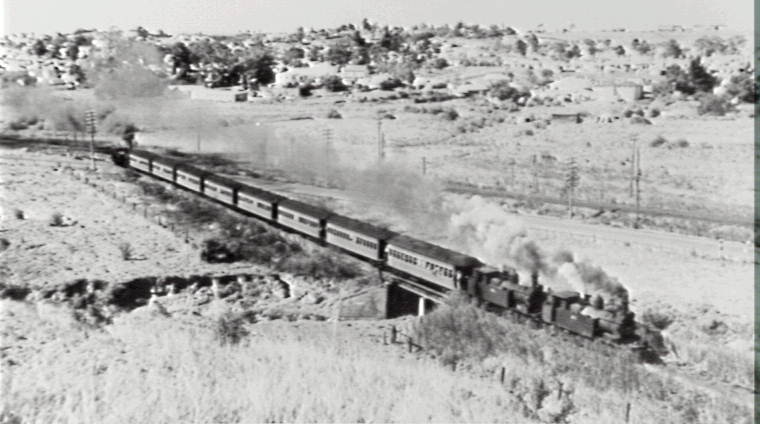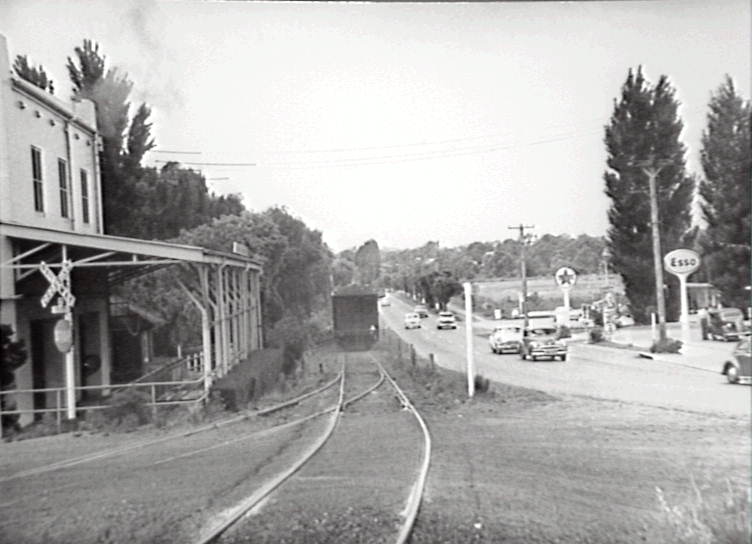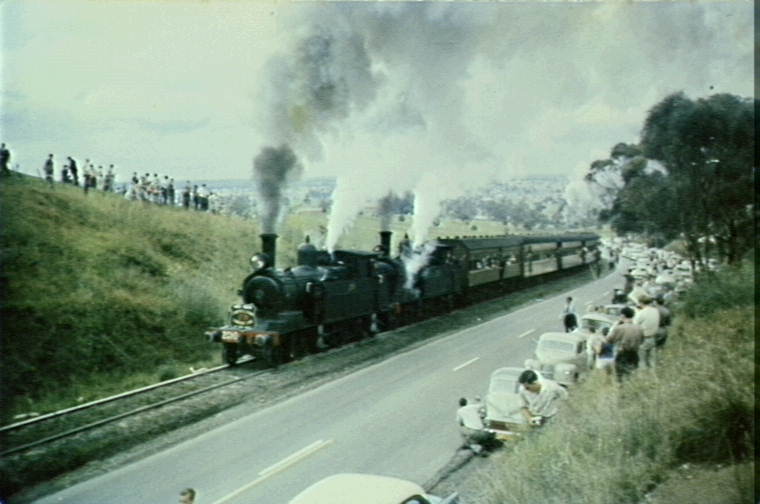THE CAMDEN TRAM
By Cindy Newman. 22 June, 1992
After Macarthur's settlement at Camden Park, "the area soon developed into a thriving agricultural community, it's main occupations being stud, stock and dairy farming." (1) The great southern railway bypassed Camden through Glenlee to Maldon so"·..deprived Camden of a direct rail connection with the Metropolis." (2) The necessity for fast and reliable transport for the butter market prompted local dairy farmers to lobby for a branch line in the 1890's. The Government responded to the calls believing the branch line was necessary but the construction of a railway would prove very expensive. A proposal was put forward for the construction of a tramway alongside the road. As a trial, a line from Blacktown to Richmond was opened in 1863. The line proved successful so was kept permanently in 1864. In 1879 this line was strengthened to take standard locomotives, but severe limitations on load restrictions halted further trials. "After the initial success of the first steam tramway between the Botanical Gardens and Redfern Station in 1879, it was urged that this service be extended to other parts of Sydney." (3) As a result a 'Tramway Extension Act' was passed on 28 April, 1880, "·..which authorised the construction of fourteen additional tramways." (4) They were to service suburbs that did not have railway communication with Sydney. A rural line was included to see if a country area could be successfully connected to the main railway. The Camden to Campbelltown route was selected because it was close to the city, well populated and had many goods to be sold on the Sydney market. Another advantage was that the Nepean Bridge was strong enough to hold the train line.

Camden train leaving Campbelltown for Maryfields Good Friday 1956 (CAHS)
The line was surveyed in 1881 several times as someone kept stealing the pegs.
On 23 May, 1881 a contract was let to Messrs. W H Topham and James Angus for the construction of the line, which was to be completed by 31 January, 1892 for a cost of £13,462, considerably less than earlier estimates had made it. (5)
Earthworks on Kenny Hill with the cutting and removal of rocks, delayed the opening of the line until 10 March, 1882.
The
branch line from Campbelltown to Camden was authorised by an Act of Parliament
on 28 April 1880, the line following the contour of the land, running beside
the road to Narellan, and climbing Kenny's Hill on the steepest grade in New
South Wales. The line, called the Camden Tramway, was opened by the Minister
for Works, Hon. John Lackey, on Friday 10 March, 1882, construction having
begun in June 1881. The tram departed from a dock on the east platform after
passengers had walked across from the mainline train to the tram. (6)
The ministerial party travelled in an official train and arrived at Camden at 3.00pm. After the speeches, the officials left again at 4.30pm and returned to Campbelltown in 40 minutes. "The original Campbelltown terminus of the tramway was a short dock platform on the eastern (town) side of the main platform." (7) From here the tram used the main southern line for about thirty chains to the junction near Camden Road, just before Bow Bowing Creek. The line then ran alongside the road until it crossed Cowpastures Road at Narellan. It then followed Cowpastures Road through Narellan and Elderslie until within twenty eight chains of the Nepean River road bridge. The bridge was a light three span timber structure built in 1860 and being 160 feet long by 15 feet wide. He tram line was located in the centre of the bridge which is a little upstream to the present bridge. From the bridge it was straight up Cowpasture Road to the Camden Terminus located on the road side just short of Edward Street, near the Dairy Farmers siding, which was not there at that time. In January1883, an extension was made and Camden Station was moved to a site between Edward and Elizabeth Streets.
"For the opening of the tramway, two Baldwin steam motors, Nos. 6 and 8, were sent from Sydney with three large, end-loading tailers, Nos. 13, 14 and 15." (8) These vehicles were fitted with railway contour wheels.
The engines were ordered from Manning, Wardle and Co. in England in 1883. In July, 1884, Nos. 292 and 293 commenced all services on the line accompanied by two specially constructed composite cars, by Hudson of Sydney.
Original stopping places were:-
Rudd's
Gate (later moved to 2nd site, then renamed Maryfields)
Kenny Hill
North Road (later moved and renamed Narellan)
Oxley Street (Graham's Hill)
Narellan (first site south of the village)
Penrith Road (Kirkham)
Carpenters Lane (Elderslie)
and the temporary terminus at Camden.
In 1893, Narellan was moved to its final site, and during 1930, a siding for the Dairy Farmer's Milk Company was opened at Camden. (9)
The original timetable showed three return trips daily. Departing Campbelltown to Camden at 5.20am, 11.00am and 7.00pm. Trips to Campbelltown from Camden also numbered three with the train departing Camden at 6.20am, 9.00am and 2.45pm on weekdays. Later in the trains life it was accounting for up to six return trips per day, the journey taking roughly 40 minutes.
On 1 January, 1889, the line was officially turned over to the Railways Department.
When the main southern line was duplicated through Campbelltown in 1891, the opportunity was taken to extend the branch line from the old junction, northwards alongside the main lines to a new dock on the western side of the station, thereby eliminating conflicting movements with main line services. (10)
So two years after the tram became part of the Department of Railways, the tram got its own platform at Campbelltown Station.
By 1899, the wooden Nepean Bridge at Camden was beginning to show signs of failure and collapse, due mainly to severe frequent flooding of the Nepean River. Plans were drawn up for a new steel and concrete structure, with the plans being approved on 26 May that year. The new plans put the rail track independent of the road on the down stream side of the bridge.
At the same time, the Railway Commissioners grabbed the opportunity to re-condition the tramway. This would be made possible by the provision of a separate steel girder bridge for the railway alongside the new steel road bridge. To assist in the construction of the two bridges, a branch line was opened 30 June, 1894. (11)
The new bridge with an independent track allowed for the use of E10 class 2-6-4 engines to work the line. This ended the 'Tramway' on 18 June, 1901 and the trains started operation the next day.
Although normal suburban passenger cars also came into use at this time, the two tramway cars (by then coded KA class) continued to share the work until 1919, when they were superseded by the CCA type, the first of which had come to Campbelltown in 1917 and which remained in use until the lines closure in 1962. (12)
This CCA class carriage was converted from the American suburban class carriages.
The safety of the train came under the Staff and Ticket regulations. Every train that left Campbelltown had to be in possession of either the staff or the ticket. That was the authority to run between Campbelltown and Camden. The staff was like a big key. It went into the box where the ticket was kept. If the train went out on the ticket then the staff had to be locked in the safe so no-one could get a train back from the other end. This meant that there could not be two trains on the single track at the one time. The section under the staff and ticket regulations was the whole line with the base at Campbelltown but with an increase in coal traffic from Narellan, this was also made a staff and ticket station, therefore splitting the section in two, Campbelltown to Narellan and then Narellan to Camden.
1936 began the annual event of the Easter Service of Via Crusis at the Franciscan Monastery adjacent to Rudd's Gate Platform. A special eight car train was used to transport the vast numbers of people travelling by rail to the service. Then Rudd's Gate facilities were not near capable of accommodating that many people, so a new station was formed, capable of holding a nine car train, on the down road side of the existing platform. 'Renamed 'Maryfields', the platform was opened in February, 1938 and Rudd's Gate was closed' (13) '·..each Good Friday, special trains of eight or nine suburban cars would run through from Sydney.' (14) To get up the steep grades of Kenny Hill and because of load restriction of 85 tonnes, three locomotives were necessary to work the service, two at the front, one pushing up the rear. When the service had concluded they returned to Maryfields, this time with one engine at the front and two at the rear, so as to have two engines running at the front when the passengers were on board.
In 1937, the movement of coal from Burragorang Valley commenced. There were three major mines in the valley at this time. S and M Fox owned two of them. Clintons owned the other one. Fox used to load coal at Camden in 1937 but the facilities where not as large as the coal loader at Narellan that Clintons used. Fox's had trouble with loading coal at Camden so they built a big coal loader at Campbelltown in 1953 while Clintons continued to load coal at Narellan. It was not until 1954 that Clintons moved their coal loader from Narellan, when it went to Glenlee, between Campbelltown and Menangle on the main southern line. Narellan was fitted with full loading facilities and storage bins in 1953 as development in industry started. Special coal trains where also used to transport the coal from Narellan to Campbelltown. '·..as loads increased, a push up engine was used as far as the top of Kenny Hill ö this permitted an increase in load from 90 to 180 tonnes. When possible, coal was also conveyed by the regular passenger or mixed trains ·..' (15)
The trains were now also carrying milk as the Dairy Farmers siding in Camden opened in 1930. The trains carried all goods to Camden and up to 40 trucks of hay in the starving stock periods. But despite this traffic including passengers, the line was still in trouble as it wasn't paying its way. Records dating back to 1904 show the train was not paying its way. Because this lost all requests for alterations or improvements were denied by the Railway Authority, even the departure time of the train could not be alteres by 2 minutes.
The train had varying experiences during its lifetime, the most common delay was that of the difficulty of climbing Kenny Hill.
Any day of the week one may see the 'tram' panting and puffing, emitting clouds of angry smoke up the preposterously steep grade of Kenny Hill. Sometimes it fails to make the grade. On those occasions it retreats in rage and humiliation to take another run at the hated lines.(16)
On other occasions the train has hit cows and on one occasion on October, 1919 it crashed through a flock of sheep. There was also an occasion where two dams burst just to the Campbelltown side of Curran's Hill station. By the time a passenger train had gone to Campbelltown and returned with a double headed coal train, the track had disappeared under the water from the dams. The line was considered pretty safe, with no persons ever being killed on the line.
On 26 August, 1948, the unusual 'windmill' road signals were installed at Narellan, the only place the train line crossed the Cowpature Road. They were installed to protect the ever increasing amount of cars travelling through the level crossing. These signals were electric motor operated level crossing signals and were used until the train line's closure.
In May 1957, C30 class 4-6-4 engines replaced the 220 class. This was because the 20 class engines were worn out and the Railway Authority did not want to repair them. However, the carriages were well looked after. Every now and then they were taken away and done up. That is probably why the carriages that were introduced in 1917 and 1920 remained in service until the line's closure. Although the engines had changed, the load restriction remained the same.. 'At the same time 41 class diesel electrics were permitted to run as far as Narellan: they were immediately replaced on coal haulage·..' (17)
As early as June 1957, the closing of the train line was being considered. With an increase in cars, fewer people were using the train and coal loading was moving to Campbelltown and Glenlee. An extra blow came in 1961 when a bus service was set up between Campbelltown and Camden. The Rail Authority had avoided this situation before when a man by the name of Herbert Miles set up a bus service in 1925. A Transport Bill was past in Legislative Assembly in 1931 which put the Camden bus service off the road. In 1961 it was back and no legislation was able to stop it. The bus service began operating as of 23 February, 1961.

Camden train at Camden beside the Old Hume Highway with milk depot on the left, 1962.
The Dairy Farmers Camden Depot had an arrangement for their milk to be transported to Sydney by road as from 1 January 1963.
So the last train departed Campbelltown Station a couple of minutes past midnight on New Years Day 1963, and arrived at Camden Station at 12.55am. The final trip was marked by someone putting grease on the track going up Kenny Hill and someone else setting fire to Kirkham Station.
The Camden Historical society hired a nine car train to run for a special last journey on New Years Day 1963. Over 500 people caught the train from Sydney via Granville for the special running. With cars lined up along the whole track for people taking pictures, it was reported to be the largest crowd to ever assemble in Camden to that date. A special ceremony was held outside Camden Station before the train returned to Campbelltown on this historical day.
The 71/2 mile track which had been transporting people and goods for the last eighty years came to an end. There is no longer any evidence of the line that ran over the steepest rail grade in Australia. The bridge has been taken over for road widening. Memories are in people's minds not in visual images. The sole survivor of a group of lines for which the community had no further need, was itself closed.

The last train on Camden railway line climbing Kenny Hill, between Campbelltown and Camden on 1st January 1963.
For those who did not see 'Pansy' as it was affectionately called by the locals, has economically being a loss, it was a great disappointment to see the line close after so many years of ambling its way through the countryside between Camden and Campbelltown
Cindy Newman lives at Elderslie and is the granddaughter of Alf & Heather Downs. A teacher of Japanese and history, she has spent 12 months in Japan teaching English and polishing up on her Japanese. This article was prepared as assignment fro her Bachelor of Arts degree, complete in 1993
Bibliography